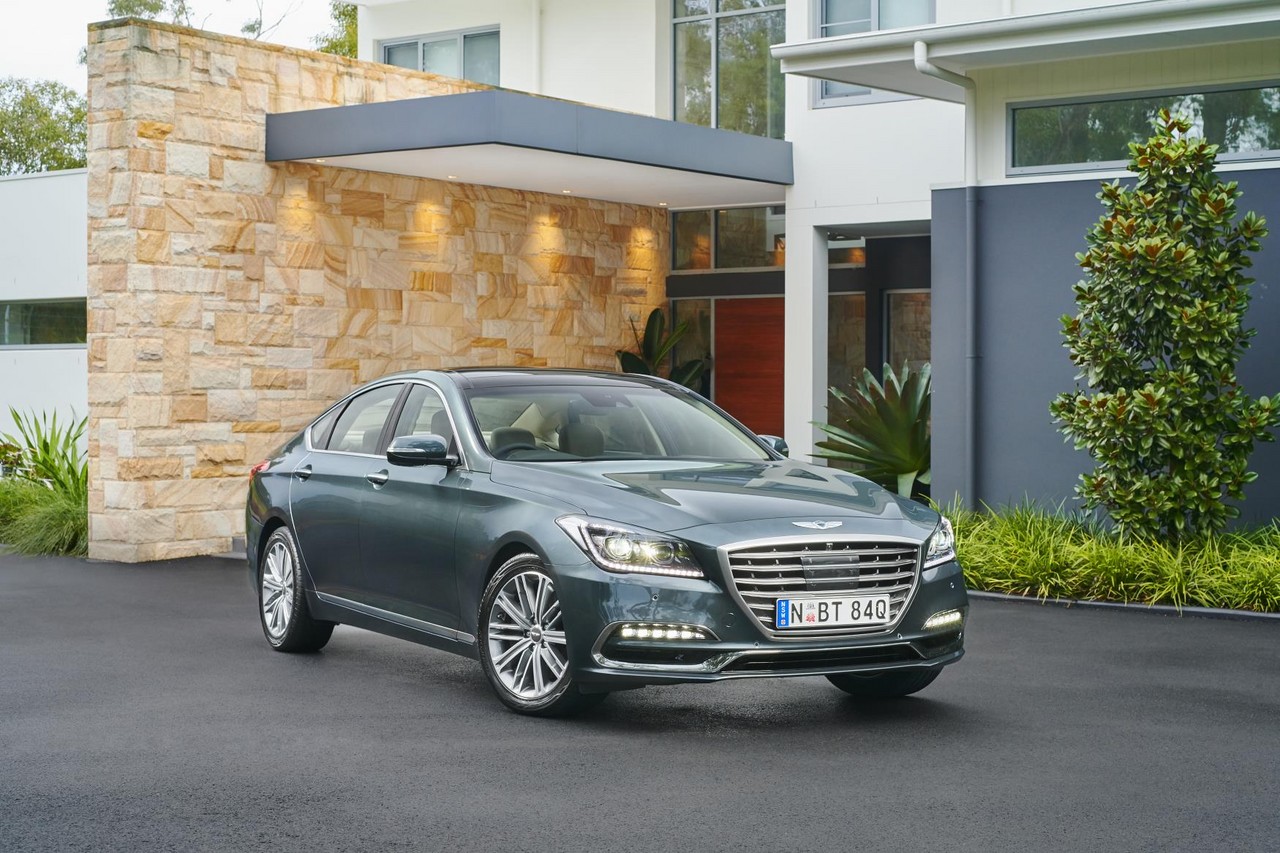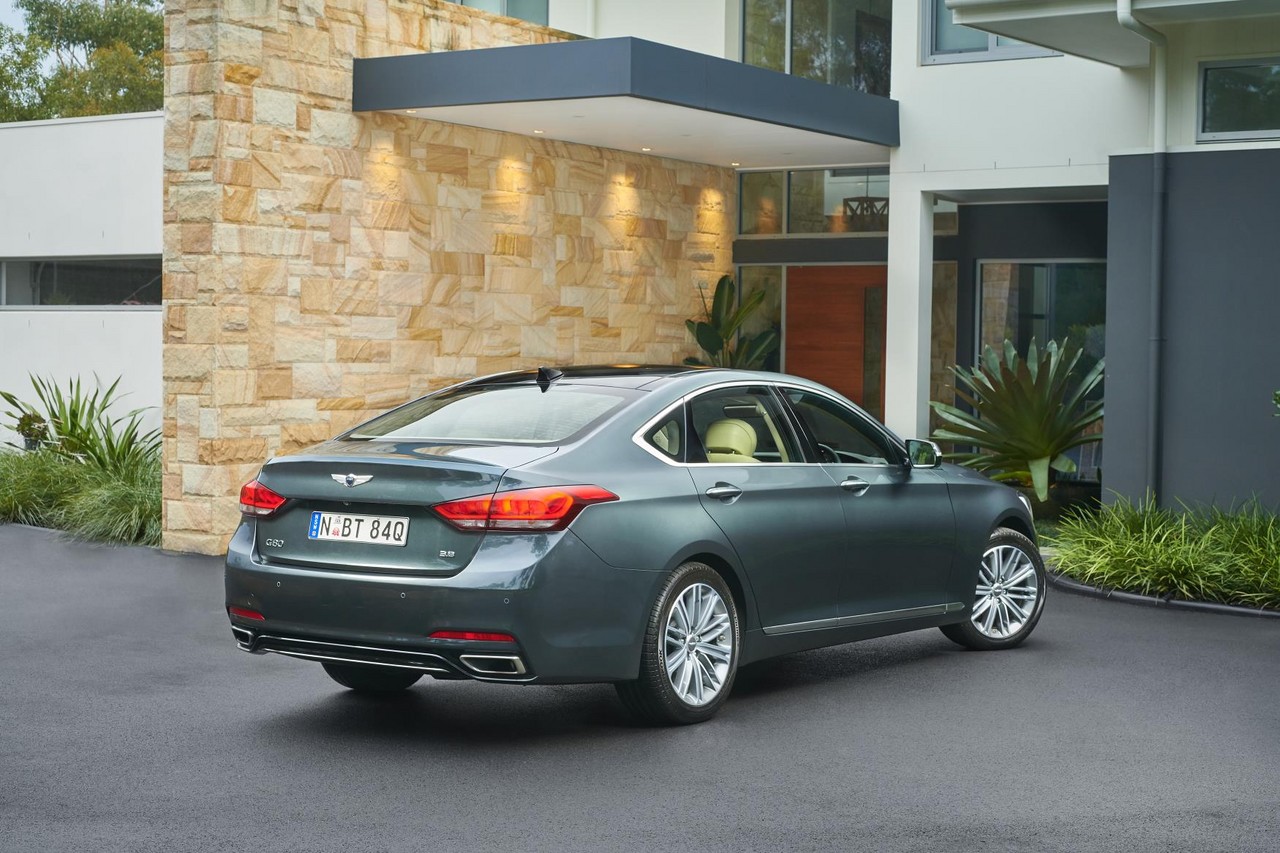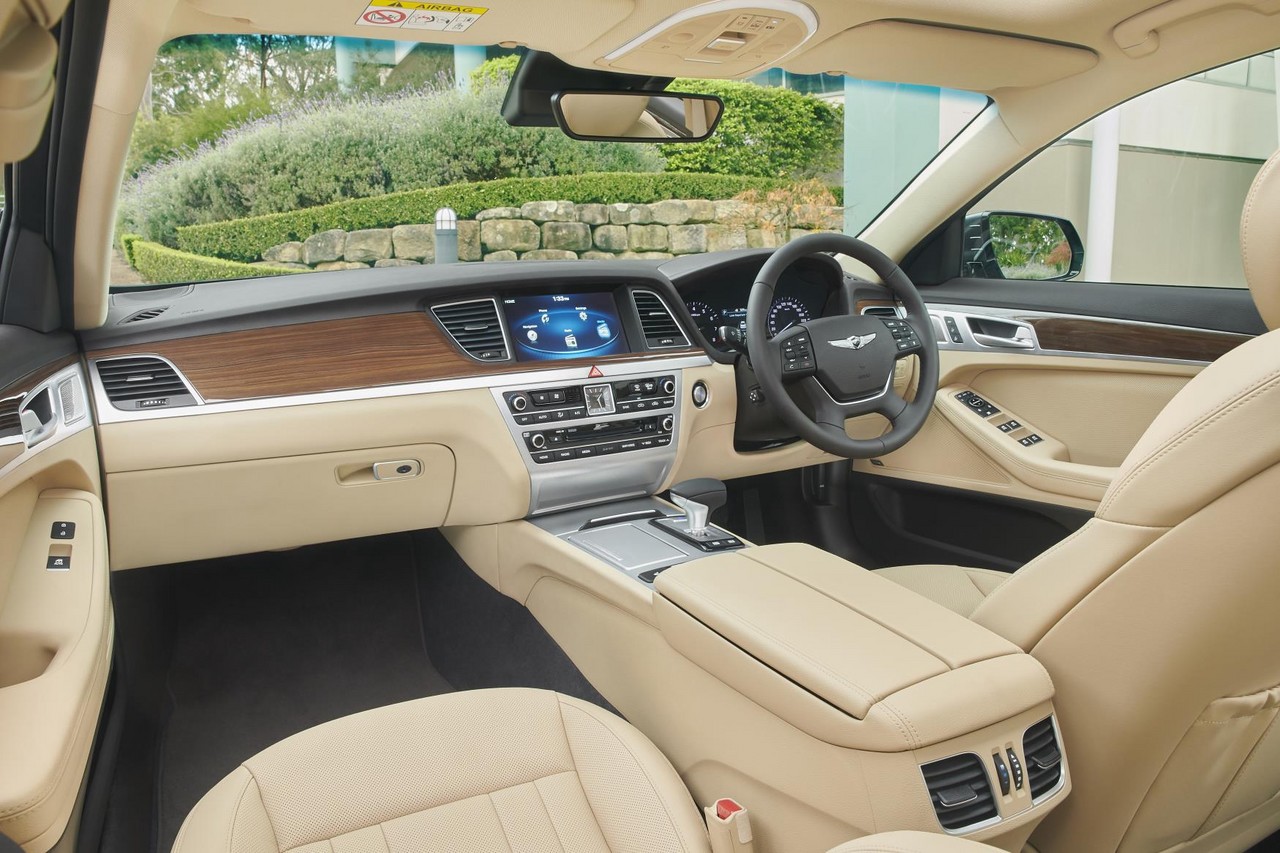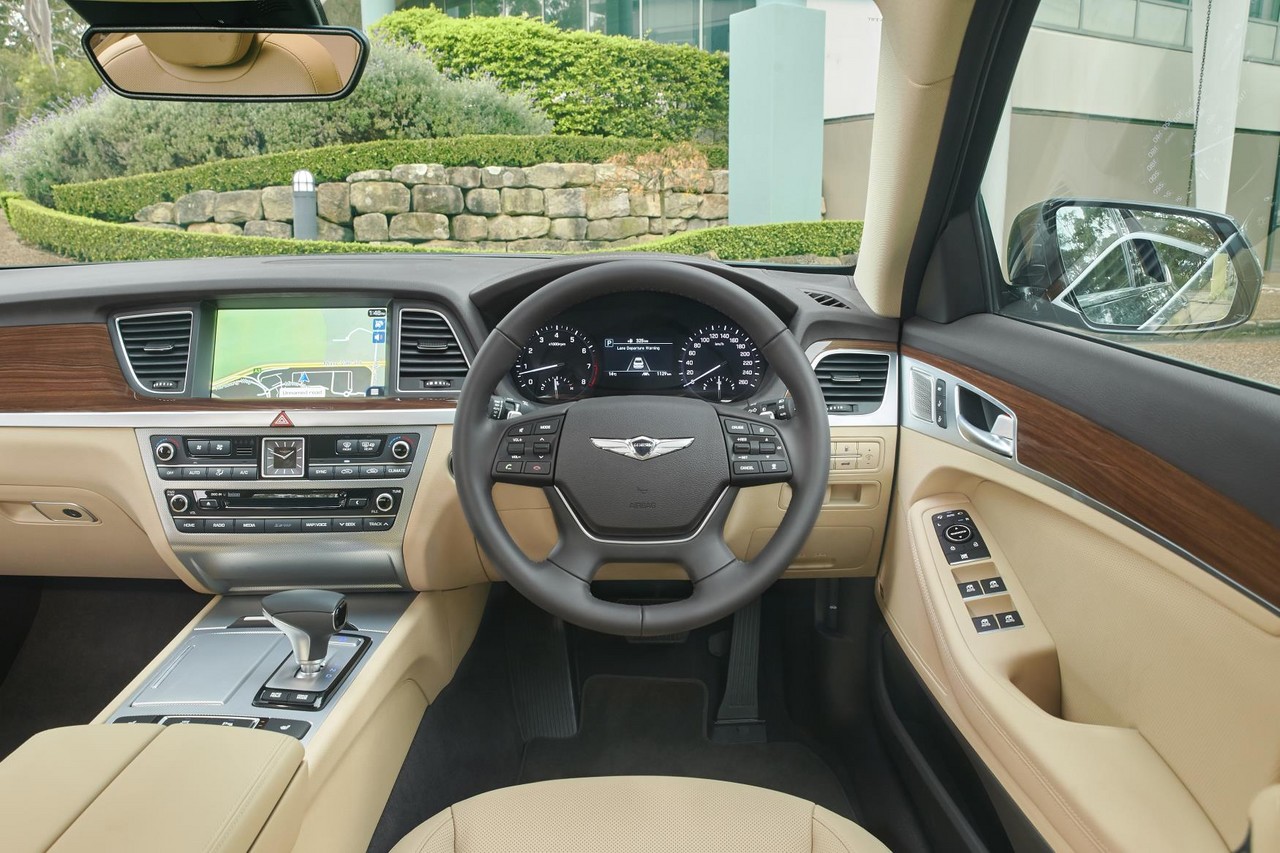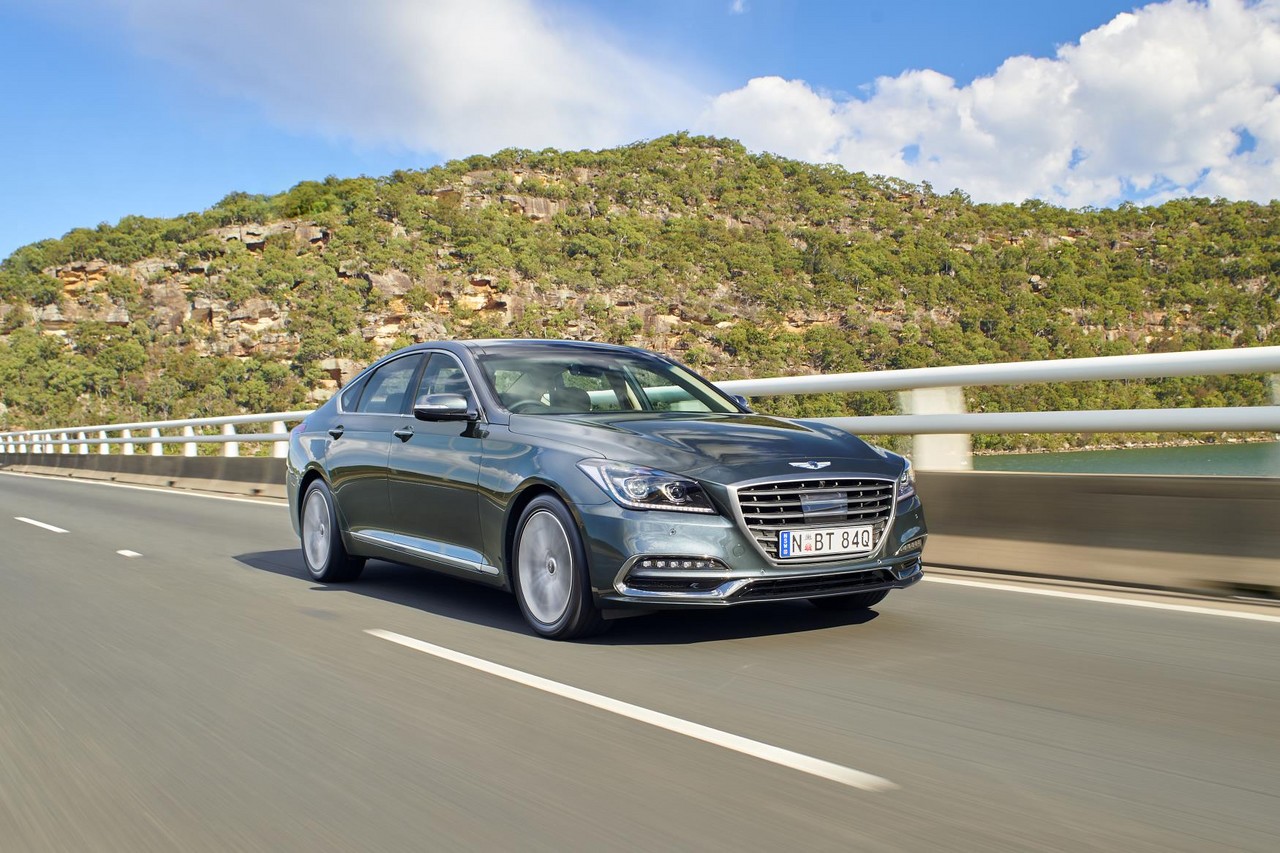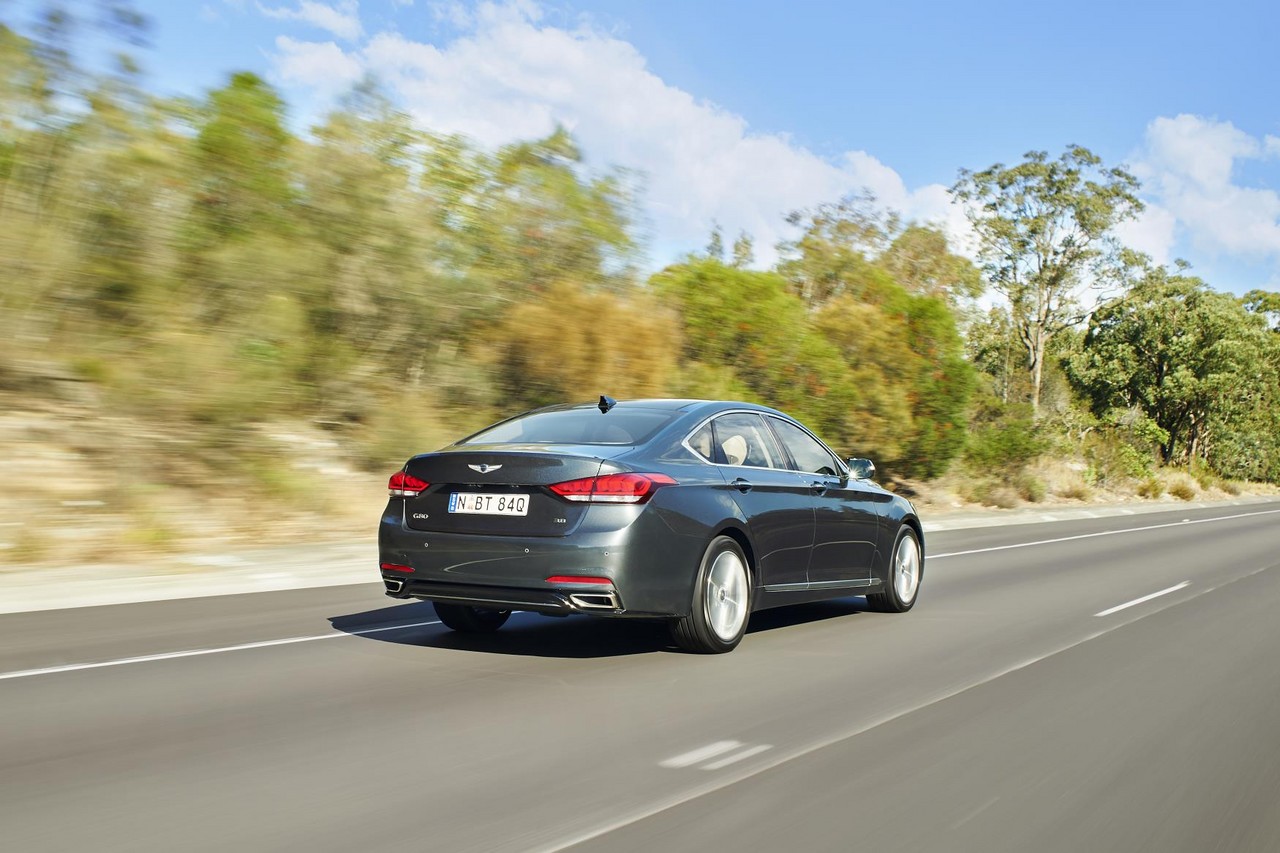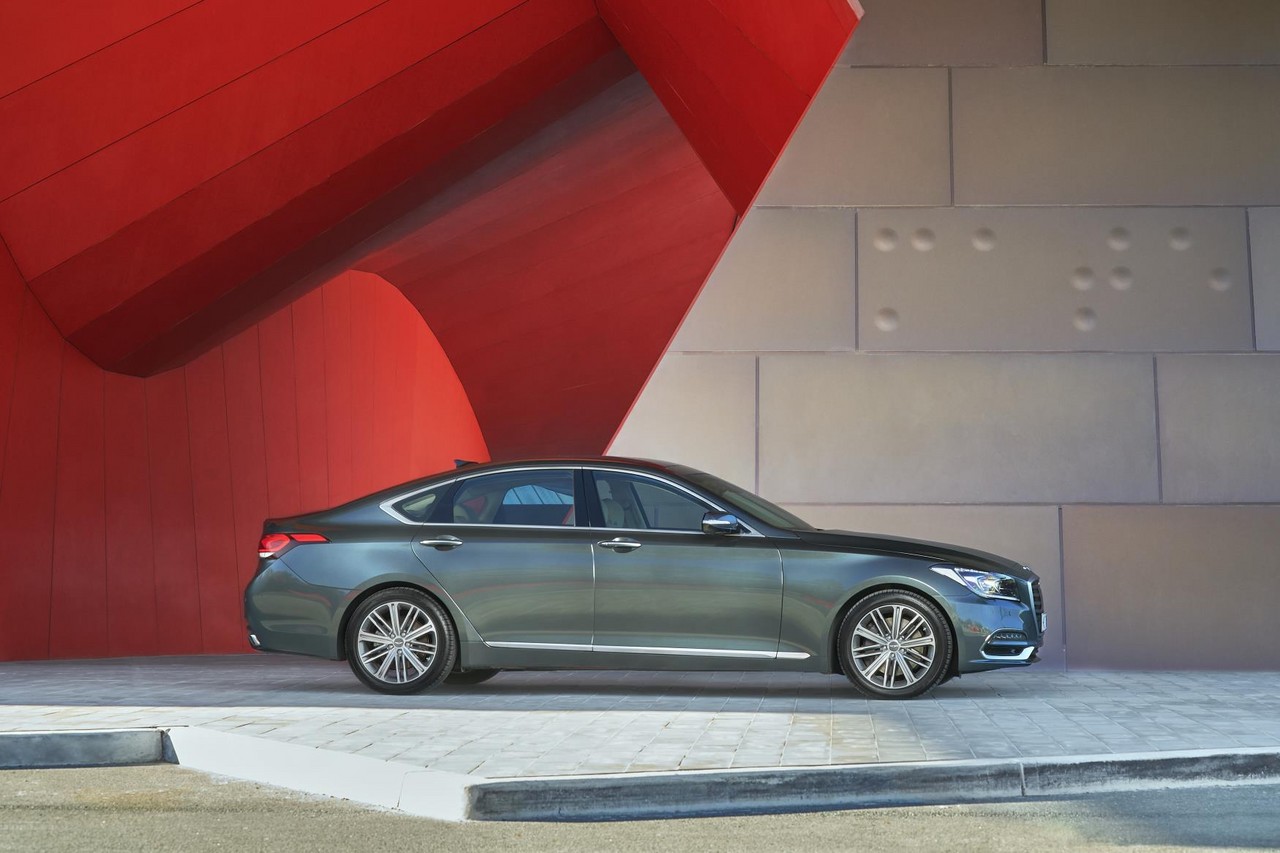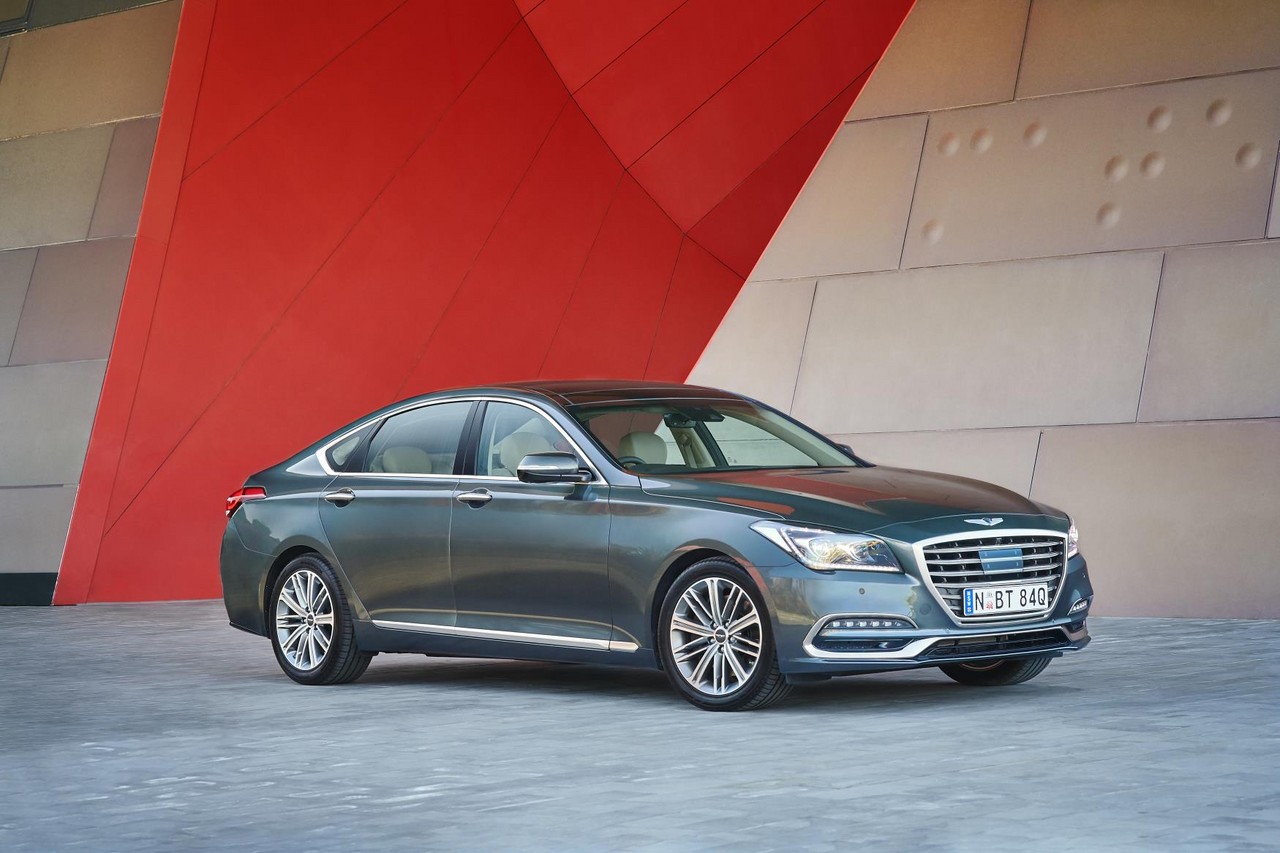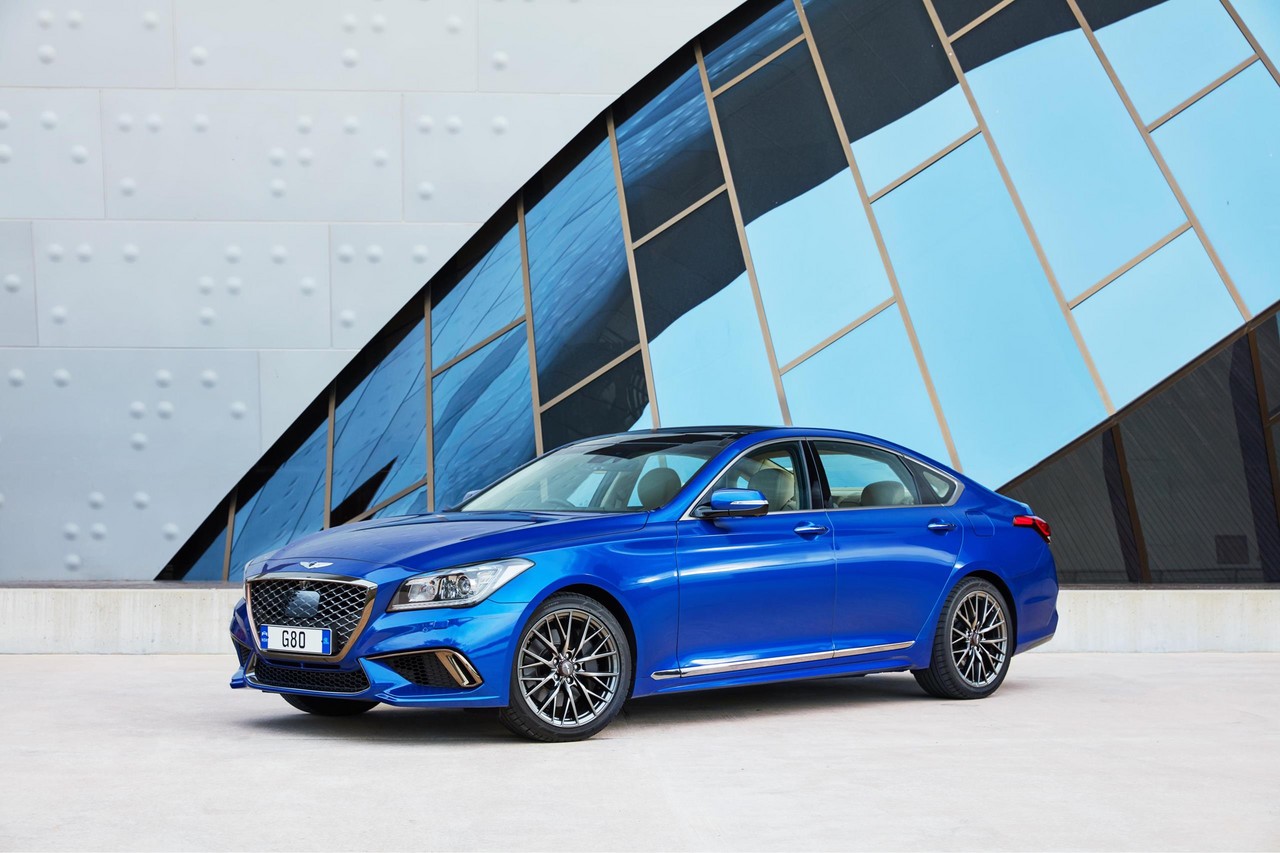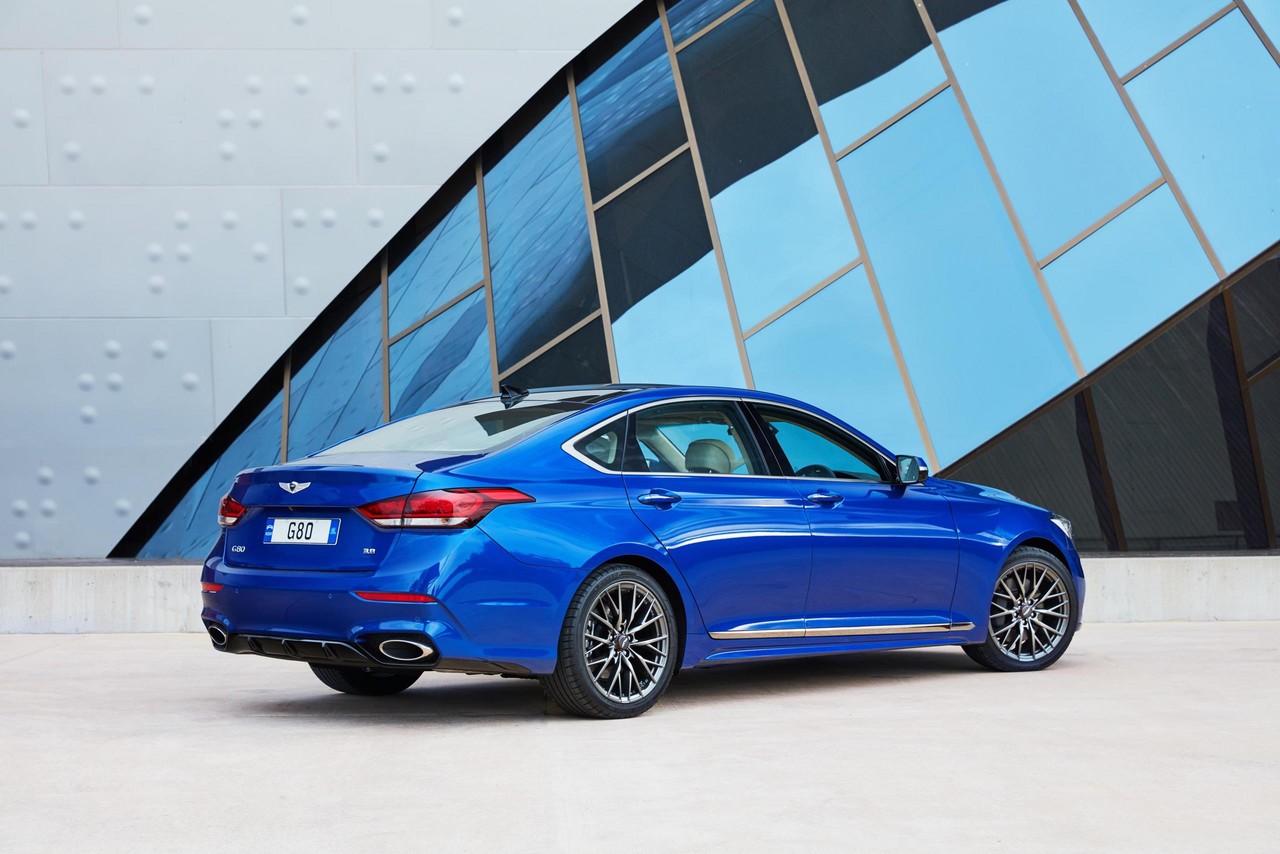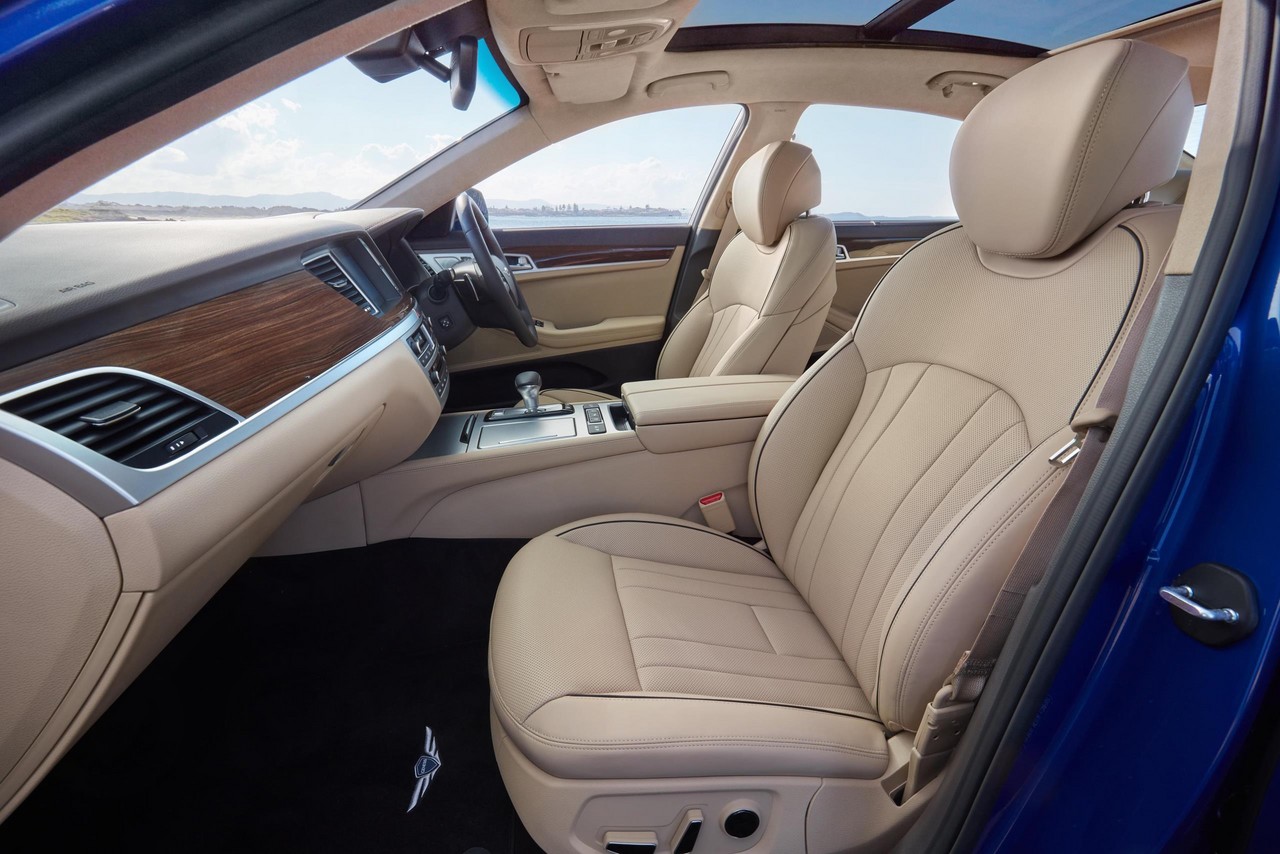
- Powerful and generally refined drivetrain
- Comfortable ride
- Spacious and comfortable interior
- Quiet, well-insulated cabin
- V6 engine is thirsty and noisy at higher rpm
- Some body roll when cornering
- Automatic transmission indecisive at low speeds
- Cheap interior switchgear
Overview
Released in Australia in June 2019, the Genesis G80 was a large, rear-wheel drive sedan. Manufactured in Ulsan, South Korea, the Genesis DH G80 was powered by a 3.8-litre V6 petrol engine that was mated to an eight-speed automatic transmission. The Genesis G80 was the first vehicle to be sold in Australia under Hyundai’s ‘Genesis’ luxury brand and was available in standard and Ultimate variants, both of which were available with the option of ‘Sport Design’ styling.
The Genesis G80 was not an entirely new model, but an updated version of the Hyundai DH Genesis . Compared to the Hyundai DH Genesis, the Genesis G80 could be identified by its ‘refreshed exterior design’ which applied to the headlights, lower front grille, front and rear fascias. Inside, the Genesis G80 introduced a new instrument cluster, gearshift knob, rear-view mirror, analogue clock and speaker design.
Upon its release, the Genesis G80 and G80 Ultimate had recommended retail prices of $68,900 and $88,900, respectively; the ‘Sport Design’ package cost a further $4000.
G6DJ Lambda V6 engine
The Genesis G80 was powered by Hyundai’s 3778 cc G6DJ ‘Lambda’ V6 engine which had an aluminium alloy block with 96.0 mm bores and an 87.0 mm stroke. Beyond this, the G6DJ engine had aluminium alloy cylinder heads, double overhead camshafts (chain-driven), direct petrol injection operating at 200 bar, four valves per cylinder, variable intake and exhaust valve timing (Dual Continuously Variable Valve Timing, D-CVVT), a three-stage variable intake system and a compression ratio of 11.5:1. Over the combined ADR 81/02 test cycle, fuel consumption was 10.4 litres per 100 km.
With its eight-speed ‘Shiftronic’ automatic transmission, the Genesis G80 could accelerate from rest to 100 km/h in 6.5 seconds.
| Engine | Trans. | Peak power | Peak torque | |
|---|---|---|---|---|
| G80, G80 Ultimate |
3788 cc G6DJ petrol V6 | 8sp auto | 232 kW at 6000 rpm | 397 Nm at 5000 rpm |
Body and dimensions
The Genesis G80 was 4990 mm long, 1890 mm wide (excluding mirrors), 1480 mm tall and had a 3010 mm long wheelbase; its drag coefficient was 0.27 Cd and boot capacity was 433 litres (SAE method). According to Genesis, the 51.5 per cent of the monocoque body consisted of Advanced High Strength Steel (AHSS) and 123 metres of structural adhesives were used. As a result, the Genesis G80 had a tare mass of 1935 kg and a 51:49 front:rear weight distribution.
To reduce interior noise, the Genesis G80 had an acoustic laminated glass windscreen; the Genesis G80 Ultimate also had acoustic laminated side windows.
Suspension
The Genesis G80 had five-link front and rear suspension with coil springs and electronically-controlled shock absorbers (‘Electronic Control Suspension’ or ECS) that could adjust compression and rebound forces up to 100 times per second. Like the Hyundai Genesis, Australian-delivered Genesis G80 vehicles had a unique suspension tune that was developed by Hyundai Australia’s engineering team.
Steering
The Genesis G80 had electric power-assisted steering (Hyundai’s Rack-mounted Motor Driven Electric Power Steering or R-MDPS). Furthermore, the steering had a ratio of 11.8:1 and the wheel required 2.55 turns from lock-to-lock.
Safety equipment
Standard safety equipment for the Genesis G80 included dual front airbags, a driver’s knee airbag, front and rear seat-mounted side (thorax) airbags, full-length curtain airbags, ABS, electronic brake force distribution, brake assist, electronic stability control, traction control and front seatbelts with pre-tensioners and load limiters.
As standard, the Genesis G80 was equipped with the following active safety technologies –
- Forward Collision-Avoidance Assist with Pedestrian Detection and Autonomous Emergency Braking (AEB): active at speeds above 8 km/h, this system used a camera mounted on the windscreen and a radar sensor in the front grille to scan the road ahead. If sensors detected that the Genesis G80 was rapidly approaching a vehicle, the driver would receive visual and audible alerts. If the driver failed to respond, emergency braking would be initiated autonomously to reduce vehicle speed;
- Smart Cruise Control (SCC) with stop & go: operating at speeds between 30 km/h and 200 km/h, SCC used a sensor in the front grille to detect traffic and would provide autonomous braking and acceleration to maintain a safe distance from the vehicle ahead. The stop & go function enabled the Genesis G80 to be brought to rest and the vehicle would automatically accelerate if the road ahead cleared and it had been stationary for less than three seconds;
Lane Keeping Assist System (LKAS): operating at speeds of 64 km/h and above, LKAS monitored the vehicle’s position within its lane. While the Lane Departure Warning System (LDWS) sounded an alarm before the vehicle crossed lane markings, LKAS provided acoustic and visual warnings before inducing corrective steering to guide the vehicle back to a safe position within its lane; - Blind Spot Collision Warning (BSCW): operating at speeds above 30 km/h, BSW used radar sensors in the rear bumper to warn the driver of an approaching vehicle via an indicator both on the head-up display and the side mirrors. If the driver activated the indicator and attempts to change lanes, the system would issue an audible warning and steering wheel vibration;
- Rear Cross Traffic Collision Warning (RCCW): when reversing out of perpendicular parks at speeds under 10 km/h, RCCW scanned areas on each side of the vehicle and would warn of approaching traffic that could intersect the G80’s path provided it was travelling at speeds between 4 km/h and 36 km/h;
- High Beam Assist (HBA): active at speeds above 45 km/h, HBA could detect oncoming traffic at night and automatically dip the high beam headlights to reduce glare. When no vehicles were detected, the system would revert to the high beam headlights; and,
- Driver Attention Warning (DAW): operating at speeds between 60 km/h and 180 km/h, DAW monitored lane position, steering angle, steering torque, vehicle position within its lane and driving patterns to detect reckless or fatigued driving. If detected, an audible tone would sound and a message would appear in the instrument display panel to alert the driver. The driver could also adjust a setting for the system’s sensitivity.
The Genesis G80 also had:
- A Pre-active Seat Belt (PSB): active at speeds above 15 km/h, PSB would tighten the front seatbelts in hazardous situations to limit longitudinal and lateral movement for greater occupant protection; and,
- Active Bonnet Lift System: in the event of a pedestrian collision at speeds between 25 km/h and 50 km/h, actuators would raise the bonnet to increase the distance between it and hard points in the engine bay to reduce the severity of a pedestrian’s impact.
Wheels, tyres and brakes
The Genesis G80 had 18-inch alloy wheels with 245/45 R18 tyres (with a space-saver spare), 345 mm by 30 mm ventilated front brake discs with four-piston fixed monobloc callipers and 314 mm by 13 mm solid rear discs with single-piston sliding callipers.
The Genesis G80 Ultimate, however, had 19-inch alloy wheels.
ANCAP crash testing
In ANCAP crash testing , the Hyundai DH Genesis received a five star adult occupant protection rating with a score of 36.88 out of 37. In the offset crash test, protection of the front occupants was generally rated as good, although protection of the driver’s chest was rated as adequate (i.e. a slight risk of serious injury). In the side impact and pole tests, however, maximum points were awarded.
Features: Genesis G80
The infotainment system for the Genesis G80 consisted of a ‘Lexicon by HARMAN ‘ sound system with seventeen speakers, a 900 watt digital amplifier and 7.1 channel surround sound, a 9.2-inch 720p monitor, satellite navigation with SUNA live traffic updates, a DVD player, a 27 GB HDD with Jukebox function, wireless mobile phone charging (Qi standard), auxiliary inputs (3.5 mm/USB/iPod), and Bluetooth connectivity and audio streaming.
Beyond this, standard features for the Genesis G80 included dual-zone climate control air conditioning, leather seats, twelve-way power adjustable and heated front seats, driver seat memory settings, cruise control, bi-LED headlights with adaptive front lighting system (AFS) and high-beam assist (HBA), LED fog lights, dusk-sensing headlights, rain-sensing wipers, a rear view camera, a rear seat ski port, steering wheel gearshift paddles, remote central locking with proximity key (for keyless entry), power adjustable mirrors with heating and folding functions, power windows, a power adjustable steering column (tilt and telescopic adjustment), push-button start, three 12 volt power outlets, an electrochromatic door and rear-view mirrors, an electronic park brake, tyre pressure monitoring system (TPMS), ambient lighting, illuminated vanity mirrors, a power operated rear blind, stainless steel scuff plates, a trip computer, an alarm and immobiliser.
As standard, the Genesis G80 was equipped with –
- A Surround View Monitor (SVM) system which could display a virtual bird’s eye view of the Genesis G80 and surrounding objects on the 9.2-inch HD central display;
- Parking Distance Warning-Forward/Reverse (PDW-F/R): operating at speeds below 10 km/h, PDW-F/R used eight surround sensors (four front and four rear) to alert the driver to surrounding objects, while the area behind the vehicle was displayed on the central display; and
- A ‘Smart Boot’ which automatically opened when the key was detected in close proximity to the boot for more than three seconds.
Features: Genesis G80 Ultimate
Compared to the standard Genesis G80, the Genesis G80 Ultimate was further equipped with Nappa leather upholstery, a sixteen-way power adjustable driver’s seat, ventilated and heated seats (front and outer rear), Easy Exit function (i.e. automatic movement of the driver’s seat after the engine is switched off), a four-way power adjustable rear seat, a head-up display, a heated steering wheel, 60:40 split rear seats (and omitting the ski port of the standard Genesis G80), a dual-panel panoramic glass sunroof, a seven-inch TFT LCD instrument cluster display, an air ioniser, rear window blinds and illuminated front scuff plates.
Genesis G80 Sport Design package
The Sport Design package for the Genesis G80 and G80 Ultimate consisted of 19-inch multi-spoke alloy wheels with a dark grey satin finish and copper highlights, a ‘Crest’ grille with dark grey mesh insert and copper highlights, unique front and rear bumpers with mesh inserts, side skirts, chrome exhaust tips, dark satin chrome door window frame mouldings, dark chrome door handle inserts and stainless steel pedal covers. Unusually, the Sport Design package omitted the bi-LED headlights with adaptive front lighting for bi-xenon headlights and halogen static cornering lights.
